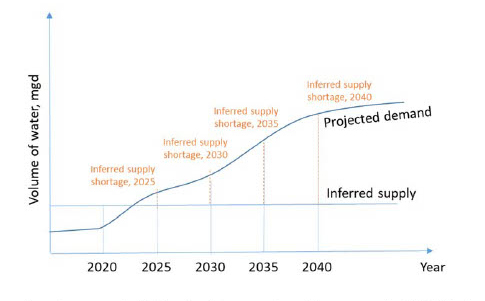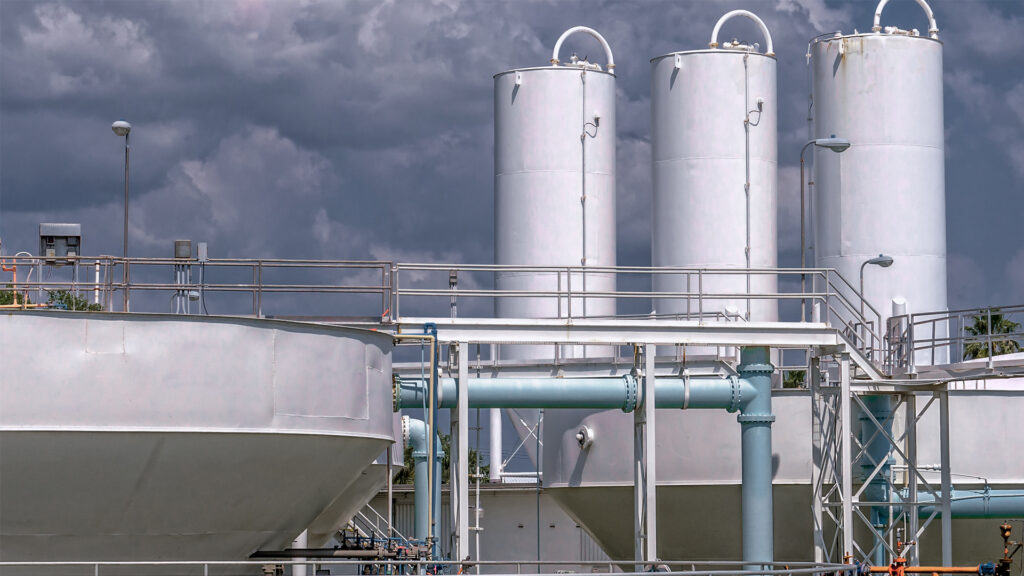By Dominic M. Calabro and Jessica Cimijotti, Florida TaxWatch
Water is a critical public resource, the importance of which cannot be overstated. An adequate supply of fresh water is necessary to meet the demands generated by Florida’s continued growth and development. In Florida, water is managed by the Department of Environmental Protection and five water management districts, who must balance water supply and demand and ensure that the state’s finite water resources are allocated appropriately.
In June, the Florida Office of Economic and Demographic Research (EDR) released an updated report detailing Florida’s water supply. According to the report, Florida could experience a water supply shortage as early as next year (2025) and it is expected to increase in severity through 2040. The state’s continued rapid economic and population growth underscores the need for a consistent, comprehensive and coordinated statewide strategy for funding water projects.

The EDR report details the state’s current water supply and demand levels and makes projections for the future use of these resources. The report also includes existing water supply development projects and provides information to the water management districts for their long-term planning efforts. Based on this information, the EDR determines whether each region has an adequate water supply to meet the future needs of Floridians.
These projections are also used to identify regions in Florida where there may be a future imbalance between the supply and demand for water resources. This imbalance is referred to as an “inferred water supply shortage.” Based on this year’s report, Florida is projected to reach an inferred water supply shortage in 2025. This shortage is expected to worsen as time goes on, especially if processes do not change.
The EDR projects that Florida will need to invest an estimated $1.7 billion for critical water projects through 2040 to avoid a significant water supply shortage. This $1.7 billion price tag is only an estimate for addressing the inferred water supply shortage, and does not consider other projects associated with restoration and certain infrastructure (e.g., stormwater and wastewater) needs. Projects such as Everglades restoration are also not part of the estimates because there is a separate plan in place for its restoration. Thus, the actual costs of protecting Florida’s water resources are almost certainly much higher than what these estimates show.
Florida has the fastest growing economy of any state. With an estimated population of 26.4 million people by 2040, this projected shortage will have an even larger impact on Florida households and the economy if it is not properly addressed. Florida will not be able to sustain this economic and population growth absent a consistent, comprehensive and coordinated statewide strategy for funding water projects.
The current selection process for funding water projects in Florida is disjointed and inconsistent. The process is spread across various grant programs, one-time investments and recurring programs in the state budget that often fluctuates. Traditionally, each water project is submitted to the Florida Department of Environmental Protection for evaluation and ranking based on the agency’s priorities. This process helps establish competitive grant programs that set statewide, coordinated and organized frameworks that align with state goals.
In the FY2024-25, general appropriations act, there were 281 water-related member projects identified by Florida TaxWatch as budget “turkeys” (totaling $410.3 million). These 281 member projects did not go through one of the proper channels to receive funding. This circumvention of the budgeting process shows the need for a more comprehensive planning process to address these selection and funding issues.

Florida TaxWatch commends the Legislature for their recent efforts to create a dedicated funding source for water projects. The Florida Legislature recently dedicated 96% of the revenues from the Seminole gaming compact to fund statewide environmental and water projects. Having a committed and recurring funding source for water projects was a recommendation in Florida TaxWatch’s 2023 report on creating a Five-Year Water Project Work Program. This report also details the various issues related to water project selection and funding processes and proposes changes to the process to better manage these projects. The report also recommends that this program creates a consistent, comprehensive, statewide planning system that selects the most beneficial water projects to receive funding.
Florida will not be able to sustain the continued level of growth it has seen over the recent years without dramatically improving how it selects and funds water projects. With less than 40% of the water supply projects having committed funding, the remaining 60% will have to come from local, regional or federal funding sources. While steps have been made in recent years to improve the water project selection process, there is still room for improvement (e.g., expansions of existing grant programs and adopting a statewide, coordinated, and comprehensive system for managing these water projects).
Florida’s growing economy and population increase the demand for water, and it is expected to continue to increase beyond 2040. Creating a coordinated and comprehensive program that addresses Florida’s statewide goals is critical. Even though the Legislature has made significant investments in water project grant programs, it is not enough. To meet the growing demand for managing these resources, the Legislature should consider implementing a Five-Year Water Project Work Program, similar to the Florida Department of Transportation Five-Year Work Program.
All Florida TaxWatch research is done under the direction of President and CEO Dominic M. Calabro. Research Analyst Jessica Cimijotti was the lead author of this report. For more information on Florida TaxWatch, its leadership and its research team, visit floridataxwatch.org.
If you are interested in submitting an opinion piece to The Invading Sea, email Editor Nathan Crabbe at ncrabbe@fau.edu. Sign up for The Invading Sea newsletter by visiting here.




Water use for irrigation needs to be addressed by requiring reclaimed water in every jurisdiction throughout Florida. Potable water should not be used for new installations, but unfortunately, reclaimed systems are only “encouraged”. Very little enforcement by regional water districts to ensure water schedules are followed for potable automatic irrigation (not to mention non-functioning rain sensors in many residential areas). Best practice designs for drip irrigation are rarely implemented. Organizations such as the one highlighted in the article need to expand their research to be more comprehensive when referring to the Floridan Aquifer.
I so often see lawns/gardens sprinklers systems watering while it’s raining! This is insane.
The most important component of meeting Florida’s future water needs is to stop promoting rapid economic and population growth.
Many years ago when Palm Beach was ready to convert the oil powered power plant in Riveria Beach to natural gas, I suggested that they co-install a desalination plant. That would allow the use of heat to assist the desalination process. Additionally one of the drawbacks to desalination is sediments, such as using seawater close to shore. Fortunately, the east coast of Florida, especially the so-called “gold coast” is close to the continental shelf break. Thus, intake could be at more than a thousand feet below surface where the water is very clear. The Bahamas uses desalination and I drink it fine. Besides desalination, perhaps cisterns should be pushed.
Overall, desalination is the way to go–look t the ocean –thee is a lot if water out there and you are only seeing the top of it. 97%+ of the water on earth is in the ocean. Only 0.7% at best is usable fresh water.